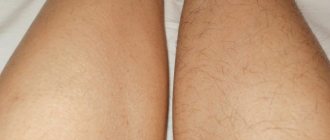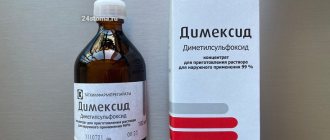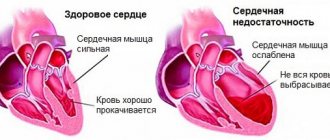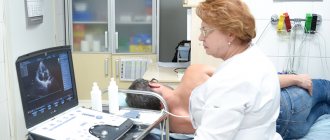Reading time: 6 min. 15 sec.
Cold hands and feet are a natural reaction of the body to hypothermia when a person walks outside in cold weather in thin shoes and without gloves. A decrease in the temperature of the extremities is also possible with insufficient physical activity. When we sit at a computer or desk for a long time, blood circulation is impaired, resulting in cold hands and feet.
If a person is constantly freezing, his fingers are always icy even in a warm room, he needs to consult a general practitioner. Cold hands can be a symptom of a serious illness. It is especially dangerous if constant chills are accompanied by numbness, tingling in various parts of the body, weight loss, tachycardia, and dizziness.
MedEx clinic doctors will determine the cause of cold hands and feet. We have modern diagnostic equipment to thoroughly examine patients.
Causes of white fever
Typically, when body temperature rises, the skin, especially on the face, becomes pink and hot. This is due to the mechanisms of thermoregulation in the human body. When excess heat is produced, the body tends to remove it. Otherwise, overheating of internal organs, protein coagulation and death occurs. Since we learned to fight fever long ago, such cases are now rather rare.
Excess heat produced is removed in two stages:
- dilation of blood vessels and an attempt to remove heat through the heated surfaces of the body;
- simultaneous cooling due to sweat secreted by evaporation from the skin.
This is how the body copes with fever on its own.
In some cases, the thermoregulation mechanism fails. The body thinks it is removing too much heat from the body when it is heated to very high temperatures. It begins to preserve it for the continuation of life. The mechanism of heat retention is the opposite of the conclusion: the blood vessels narrow, sweat stops being released. As a result, the person has a high fever and cold hands and feet.
White fever is very dangerous. Heat does not stop being produced in the body in response to the action of an infectious agent and inflammation, but it stops being released. As a result, overheating of internal organs can occur very quickly. This is especially dangerous for young children, since their thermoregulation is imperfect, and all processes in the body occur faster. That is, unpleasant consequences will occur much earlier than in adults.
Expert recommendations
Doctors around the world tell patients that cold hands in hot weather cannot be ignored. In the presence of pathology, wasting time can lead to irreversible consequences. Let me give you an example of diabetic foot syndrome. This is a dangerous condition in which the main blood flow in the arteries of the lower extremities is significantly reduced. Cold feet are the first sign. Then, as a result of deterioration of tissue trophism, non-healing ulcers form and infection develops. The worst prognosis is limb necrosis. Complications can be prevented if treatment is started on time. This is the answer to the question of why run to the doctor when a person constantly has cold extremities.
Dzhgarkava Tea Gochaevna
Therapist-cardiologist Experience 5 years
Symptoms of the condition
It is important to recognize white fever in a timely manner in order to help a person. There are several signs of this condition:
- elevated temperature (it is better to measure on the forehead with a non-contact thermometer, since under the arms there may be a distortion of the results);
- cold hands and feet;
- chills;
- pale skin;
- lethargy and weakness;
- moodiness in children;
- lack of appetite.
If a person is diagnosed with white fever, it is necessary to monitor compliance with the drinking regime. This is especially important for children, as they become dehydrated very quickly.
Cold hands: what is the reason and what to do?
Cold hands are considered a woman's disease. Representatives of the fair sex from 15 to 45 years old especially often complain about low temperature of the extremities. This is due to the fact that women have weaker thermoregulation of the body than men. Perhaps you just dress lightly and it's all about hypothermia. Then it’s enough to reconsider your wardrobe. In addition, this is a common symptom in smokers, as well as with severe anxiety and fatigue. However, this phenomenon may also be based on illness.
Iron-deficiency anemia
Take the test
Weather sensitivity test
Goosebumps
Iron is the main component of hemoglobin in the blood, the main transport vehicle for oxygen. Lack of iron leads to disruption of metabolic processes in cells, including energy. This occurs due to poor nutrition, impaired absorption of iron in the gastrointestinal tract, increased blood loss (nasal, uterine, etc.), with a special need for it (pregnancy, lactation, rapid growth), etc. Additional signals - pallor skin and mucous membranes, dizziness, fatigue, tinnitus, rapid heartbeat.
What to do?
First of all, a clinical blood test is required. The normal hemoglobin level in children under 6 years of age is 110 g/l, in children over 6 years of age and adults – 120 g/l. A special diet is important - less milk, more meat, fruits and vegetables. Iron supplements are taken in combination with ascorbic acid.
Vegetovascular dystonia
In this case, hot and cold flashes, lack of air, dizziness are felt, and blood pressure rises and falls. Irritability increases and fatigue increases. From time to time I experience pain in the heart and tingling in various parts of the body. Moreover, the examination does not reveal signs of damage to organs and systems. The cause of the malaise is a disruption of the autonomic nervous system, which regulates the entire body.
What to do?
It often occurs against the background of many diseases, so it is important to undergo a full examination, especially by an endocrinologist and neurologist. Physiotherapy, exercise therapy, and psychotherapy help to cope with the disease.
Thyroid diseases
The thyroid gland is a key link in the hormonal regulation of the entire body. With hypothyroidism (lack of thyroid hormones), metabolic processes slow down. Lethargy and lethargy, drowsiness, and excess weight appear. The person feels depressed. The face, especially the eyelids, swells, and the pulse slows down. The skin becomes dry, often flakes, and thickens. The functioning of the mechanisms responsible for maintaining normal body temperature is disrupted. When thyroid hormone levels are low, a person often feels cold.
What to do?
It is important to undergo an examination by an endocrinologist, do an ultrasound of the thyroid gland, and take a general blood and urine test. If necessary, the doctor may prescribe additional X-ray and magnetic resonance imaging, computed tomography, etc.
Treatment methods
During white fever, two symptoms need to be relieved: fever and vasospasm of the extremities. Treatment should be aimed at both at the same time:
- taking antipyretic drugs to reduce body temperature: based on ibuprofen (Nurofen, Ibuprofen) or paracetamol (Panadol, Paracetamol);
- antispasmodics (“Drotaverin”, “No-shpa”, “Spazmalgon”).
Children are given drugs in the form of syrup; adults can use tablets. Some medications come in the form of liquid capsules. They act faster and have a more pronounced effect. It is also necessary to pay attention to the dosage. It must correspond to the age and weight of the patient.
If white fever is diagnosed in a small child, it is advisable to call an ambulance. Doctors will be able to objectively assess the condition and suggest why the hands and feet are cold at a temperature in order to avoid a recurrence of the attack.
Dear patients! Remember that only a qualified doctor can make an accurate diagnosis, determine the causes and nature of the disease, and prescribe effective treatment. You can make an appointment with our specialists or call a doctor at home by calling 8-(4822)-33-00-33
Be healthy and happy!
Iron-deficiency anemia
Iron is the main component of hemoglobin in the blood, the main transport vehicle for oxygen. Lack of iron leads to disruption of metabolic processes in cells, including energy. This occurs due to poor nutrition, impaired absorption of iron in the gastrointestinal tract, increased blood loss (nasal, uterine, etc.), with a special need for it (pregnancy, lactation, rapid growth), etc. Additional signals - pallor skin and mucous membranes, dizziness, fatigue, tinnitus, rapid heartbeat.
What to do?
First of all, a clinical blood test is required. The normal hemoglobin level in children under 6 years of age is 110 g/l, in children over 6 years of age and adults – 120 g/l. A special diet is important - less milk, more meat, fruits and vegetables. Iron supplements are taken in combination with ascorbic acid.
Thyroid diseases
The thyroid gland is a key link in the hormonal regulation of the entire body. With hypothyroidism (lack of thyroid hormones), metabolic processes slow down. Lethargy and lethargy, drowsiness, and excess weight appear. The person feels depressed. The face, especially the eyelids, swells, and the pulse slows down. The skin becomes dry, often flakes, and thickens. The functioning of the mechanisms responsible for maintaining normal body temperature is disrupted. When thyroid hormone levels are low, a person often feels cold.
What to do?
It is important to undergo an examination by an endocrinologist, do an ultrasound of the thyroid gland, and take a general blood and urine test. If necessary, the doctor may prescribe additional X-ray and magnetic resonance imaging, computed tomography, etc.
Treatment
Help before diagnosis
If chilliness occurs against the background of banal hypothermia, the person needs to be warmed up as soon as possible. For mild hypothermia, use warm drinks, baths, and heating pads. The temperature must be increased gradually. For superficial frostbite, warming bandages are applied to the legs. With moderate and severe hypothermia, the patient requires comprehensive medical care.
To correct vegetative-vascular dysfunction or physiological hypotension, non-drug measures are sufficient. Patients experiencing chilliness are advised to normalize their work and rest schedule, walk more in the fresh air, and begin dosed training in the gym. It is recommended to limit watching TV and surfing social networks. A balanced diet high in vitamins helps improve your well-being.
Conservative therapy
Medicines are selected taking into account the etiological factors of chilly feet. In cases of arterial circulation disorders, infusions of saline solutions and antiplatelet agents, which prevent the adhesion of red blood cells and increase blood fluidity, show a good effect. To prevent thrombosis, anticoagulants are included in therapy. Dilatation of peripheral vessels and improvement of blood flow is achieved by taking antispasmodics.
For obliterating atherosclerosis, which causes chilly legs, lipid-lowering drugs are effective, reducing cholesterol and LDL levels and preventing the appearance of new lipid plaques. For endarteritis, pathogenetic treatment includes anti-inflammatory drugs and corticosteroids, which neutralize pathological changes in the vascular wall.
In case of insufficient venous outflow, phlebotropic agents are used in combination with elastic compression. To influence trophic ulcerative defects, local effects in the form of creams or ointments are indicated. Patients with polyneuropathy are recommended to take B vitamins, which improve neuromuscular transmission. The therapeutic regimen is supplemented with neurotrophic drugs.
To eliminate chilliness associated with obliteration of the vessels of the legs, physiotherapy is used: electrophoresis with medicinal solutions, ozokerite applications, diadynamic currents. Hyperbaric oxygenation helps improve tissue oxygen supply. General strengthening balneological procedures are actively prescribed: pine, pearl or radon baths.
Atherosclerosis
There is a thickening and loss of elasticity of the walls of the arteries, a narrowing of their lumen with subsequent disruption of the blood supply to the organs. Hence the cold hands. When cerebral vessels are damaged, tinnitus, dizziness, memory loss, and headache are noted. Eating with an excess amount of animal fat, a sedentary lifestyle, and psycho-emotional stress can lead to this disease.
What to do?
An ECG, ultrasound of the heart and blood vessels, rheovasography, angiography, coronary angiography are performed, blood pressure is measured, lipid levels (cholesterol, etc.) and blood sugar are examined.
Kinds
Cold hands disease can be divided into two types: physiological and pathological.
Physiological can be caused by cooling, a sedentary lifestyle, a strict diet, disruption of the daily routine, taking certain medications, abuse of tobacco products, previous cooling of the extremities, and so on.
Pathological testifies to the presence of diseases of the thyroid gland, nerves and blood vessels. In this case, you need to immediately consult a doctor, since coldness of the extremities is a symptom.
Diagnostics
The examination of a patient with complaints of chilly feet begins with a family doctor (therapist), who, if necessary, involves highly specialized specialists in the diagnostic search - vascular surgeons, neurologists, endocrinologists. During a physical examination, the color and temperature of the extremities are assessed and signs of venous stasis or ischemia are identified. For diagnostic purposes, the following instrumental and laboratory research methods are used:
- Doppler ultrasound of leg vessels.
Duplex scanning of the arteries and veins of the lower extremities shows the speed of blood flow, pathological reverse blood flow, visualizes blood clots and lipid plaques blocking the lumen of blood vessels. Features of microcirculation are assessed according to rheovasography and capillaroscopy. - Angiography.
The method is used to diagnose obliterating processes of the lower extremities that cause chilliness. Peripheral arteriography shows narrowing or blockage of the lumen of the arteries and helps assess the size and extent of plaques. Ascending phlebography of the legs is indicated for studying venous blood flow, the condition of the deep and superficial veins. - ECG.
To confirm arterial hypotension, arrhythmia and other cardiac pathologies, a cardiogram is recorded at rest and with stress tests. To clarify the diagnosis, an orthostatic test and echocardiography are recommended. To assess daily fluctuations in blood pressure, Holter monitoring is performed. - Neurological diagnostics.
A standard examination includes testing of superficial and deep sensation, reflexes, muscle tone and strength. For a qualitative assessment of neuromuscular transmission, electroneuromyography is prescribed. In case of osteochondrosis, the results of an MRI or CT scan of the spine are informative for a neurologist. - Laboratory techniques.
Based on the results of a clinical blood test, anemia and its probable causes are diagnosed. Biochemical research is aimed at identifying nutritional deficiency. When cold feet are of endocrine origin, an expanded hormonal profile is studied.
Consultation with a vascular surgeon
Scleroderma, Raynaud's syndrome
The fingers or toes become cold, numb, a tingling sensation appears in them, and they become white or even bluish in color. This occurs under the influence of stress or temperature exposure and can last from several minutes to several hours. At the end of the attack, the bluish skin turns red, fever and pain appear. This is Raynaud's syndrome - one of the manifestations of scleroderma. As a result of damage to the blood vessels, many organs and tissues of the body are affected, especially the skin. The face takes on a mask-like appearance, and it is difficult to open the mouth. It is believed that scleroderma is stimulated by viruses, poisoning, and congenital predisposition. This disease occurs 5 times more often in women than in men.
What to do?
At the first symptoms, you should urgently consult a dermatologist. They conduct laboratory tests of blood, urine, immunodiagnostics, X-ray examination of bones and joints, ultrasound of internal organs, and cardiac diagnostics.
Causes
Cold hands are just one symptom of various neurological diseases.
- Raynaud's disease with vascular neurosis provokes spasms of small arteries and cold intolerance.
- Vegetovascular dystonia.
- Lesions of peripheral nerves.
- Diabetes.
- Heart failure.
- Consequences of acute cerebral circulatory disorders, paresis or paralysis.
Vegetovascular dystonia
In this case, hot and cold flashes, lack of air, dizziness are felt, and blood pressure rises and falls. Irritability increases and fatigue increases. From time to time I experience pain in the heart and tingling in various parts of the body. Moreover, the examination does not reveal signs of damage to organs and systems. The cause of the malaise is a disruption of the autonomic nervous system, which regulates the entire body.
What to do?
It often occurs against the background of many diseases, so it is important to undergo a full examination, especially by an endocrinologist and neurologist. Physiotherapy, exercise therapy, and psychotherapy help to cope with the disease.







